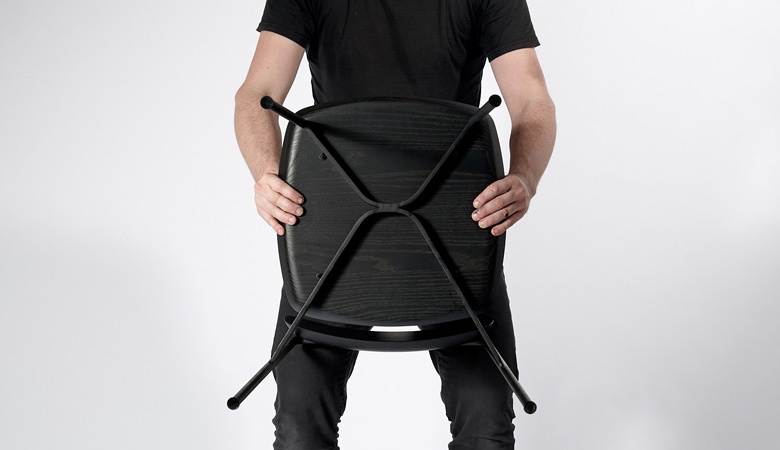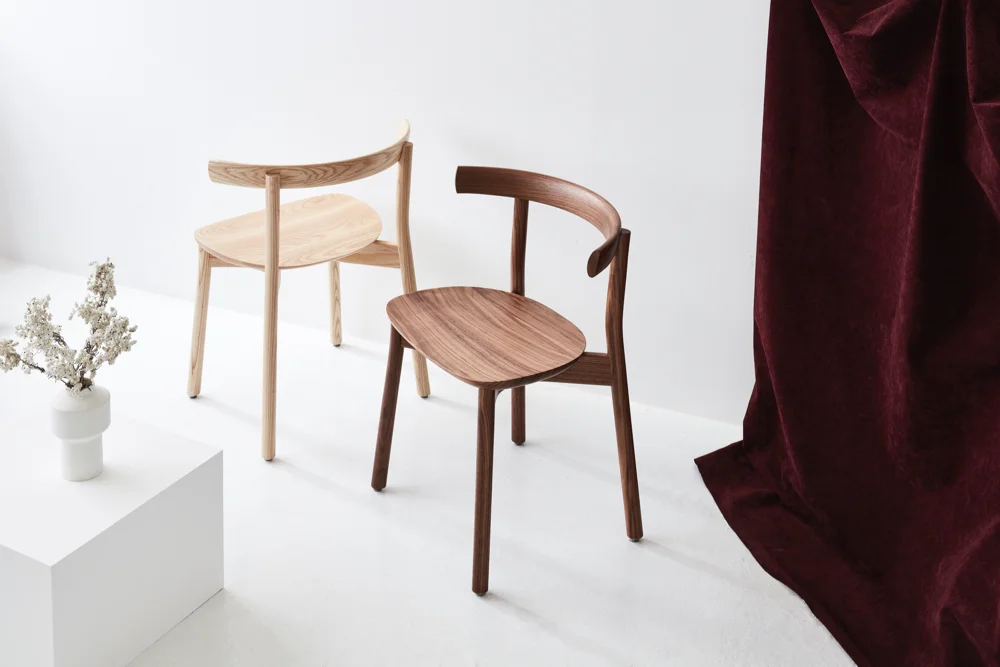I have to admit that the idea for a post on the anatomy of a chair came from the name of a book called Chair Anatomy by James Orrom published by Thames & Hudson. With the release of Chris Nicholson’s ‘Torii’ chair for Dessein Furniture in mid November, Design daily was prompted to think about how different designers approach the same brief - in this case the dining chair - and immediately thought of Tom Fereday‘s recent ‘Sia’ chair for Nau as an example of another Australian chair that took a refreshingly different approach.
Both chairs are stacking designs (which is quite a rare thing) that are designed and made in Australia using carefully shaped solid wood elements. The ‘Torii’ chair - named after the Japanese Torii gates - is an expression of Nicholson’s joinery background being an all wood design with strong links to mid century Danish furniture while Fereday’s ‘Sia’ is more of a hybrid of an old industrial product involving a pivoting backrest with a skeletal stainless steel frame.
The concept of the pivoting backrest is nothing new but Fereday’s self lubricating bronze sleeve takes the source of inspiration - old factory chairs - to a new level. The movement of the back makes the chair more comfortable for a wider range of people and this comfort allows the chair to become viable as a restaurant dining chair without the need for upholstery. It might appear counter intuitive but having an articulating back makes up for the lack of flex in the solid timber seat. This way the designer was allowed to design for a certain purity of shape rather than being nagged by the tyranny of comfort and it must be said that this is often what drags a beautifully simple design into visual mediocrity. To achieve both beauty and comfort in the one design is the holy grail.
It was the search for comfort within a visually light and small chair that drove Fereday to develop ‘Sia’. "The dining space is often tricky in terms of the space available. The brief I set myself with ‘Sia’ (which means movement in Hindi) was to create a slim chair that was comfortable," says Fereday. "Quite often with those types of chairs the compromise is comfort, so that was the reason for developing the articulating backrest. Each element of the chair performs an important function in resolving the design in an elegant manner. The form of the 'x' frame allows for the frame to be flexed and assembled to the backrest without use of any permanent fixings. Then once the seat element is assembled to the frame the entire form becomes rigid whilst allowing the backrest to pivot. Importantly this also allows for any part of the chair to be easily repaired or replaced creating an incredibly long lasting and durable design”.
For Fereday the initial detailing of the shape of the backrest and seat of his ‘Sia’ chair was explored through cardboard models where rather than having each iteration of a shape made from wood, he was able to carve away at ribs of cardboard with a box cutting knife.
Work on resolving the chair from its cardboard origins (left) went on for many months until the entire construction method was re-evaluated and an incredibly simple but effective base was created (right). Launched in March 2018 by major furniture importer Cult after winning the Mercedes Benz Design Award late in 2017, the chair has been widely applauded for its lightness, strength and comfort. Nau a new brand under the Cult umbrella concentrates on Australian designed products by designers such as Adam Cornish, Jack Flanagan, Adam Goodrum,and Gavin Harris. The chair has gone on to win gold at the Good Design Awards 2018.
It’s interesting to note here that pivoting back rests appeared in Danish furniture too - one notable example being Hans Wegner’s CH 35 for Carl Hansen from 1960. Unfortunately no longer in production, the chair was an even more comfortable version of Wegner’s classic Round chair (also known as The Chair). While Nicholson didn’t go down the articulating backrest path he did embrace the quintessentially Danish concept of the half arm - a continuation of the backrest to the point where it becomes a perching position for the elbows but which doesn’t need to be look cumbersome and heavy. This type of backrest is universally more comfortable than the same chair with a standard backrest. “Prototypes were developed and refined in order to perfect some of the challenging details” says Nicholson. “The backrest was one particular area that required substantial development. We wanted the backrest to also function as an elbow rest without hindering the lightweight appearance of the chair, or its stackability”.
The ‘Torii’ chair is in fact full of interesting construction details like the visible dowel joints where the backrest is fixed to the back legs via a half cut in the leg and most significantly the curved cross bracing between the legs. The backrest is oval in shape, reminiscent of the scabbards (or Saya in Japanese) of Samurai swords. Once you start examining this chair you quickly realise that it is not as simple as it first appears, with all manner of subtle curves radii and complex profiles in use. It is startling how much care has been applied to the details given its price. Weighing in at 8kg the ‘Torii’ chair will win no weight contest but it is its solidity and sculptural qualities that mark it out from many other contemporary chair designs.
With the recent proliferation of cnc technology, solid shaped seat and backs on chairs have become more achievable and creating parts of this nature now requires less labour, so prices can be kept more reasonable. In an era where solid wood is a symbol of luxury, the fact that these chairs sell for less than one thousand dollars is surprising but very welcome. Michele Chow, the founder and CEO of Dessein Furniture has worked hard to maintain affordability within the brand since day one, with Dessein’s initial range being made from rubber wood that she knew was able to be manufactured in Asia for a very reasonable price. Her initial goal was to use quality design to elevate the perceived value of rubber wood furniture but over the last 6 years the brand has shifted to a more Australian made emphasis using rare submerged woods from a lake in Tasmania for one collection in 2017 and now a move toward new products that use more conventional timbers in conjunction with highly resolved design to enhance commercial viability.
“I was introduced to furniture design/making while at university” says Nicholson. ”I had a part-time job in a commercial joinery workshop making timber furniture and windows. I was studying engineering at the time so the ability to design an object and then also design the means of manufacturing was very appealing to me. In 2013 I rented my first warehouse and established my joinery business, Forest Furniture, in the coastal city of Wollongong”.
Nicholson goes on to describe what he seeks in his work and what appeals to him about certain designs. “I like how chairs can have personality. Some are bold or sleek while others can be soft or playful. The chairs I appreciate the most all have a certain flow between their components. Every part complements its adjoining piece to form one, uniform aesthetic. The ability to do this, while also creating something that is beautiful to look at and comfortable to sit on, is something I really appreciate in a chair”.
For more information and pricing on the ‘Torii’ chair by Chris Nicolson contact Dessein Furniture here.
For more on the ‘Sia’ chair by Tom Fereday for Nau click here.













